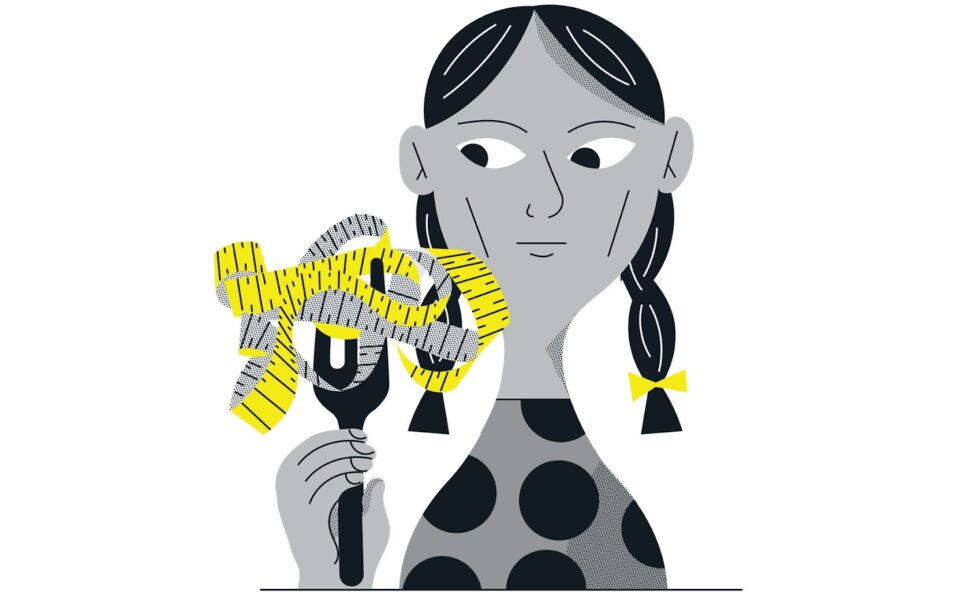Post-pandemic surge in child eating disorders: A mother’s story, expert insights

What’s it like to watch your 10-year-old son stop eating? What’s it like to watch him get weaker and weaker, to see him disappear before your eyes day after day? “From one moment to the next, I felt like I was losing my child,” Katerina (not her real name) tells Kathimerini. It happened a year and a half ago. Katerina and her husband, who have always been very close to all three of their children, immediately went to the pediatrician when they noticed that the little one had lost some weight. He told them not to worry. It was the beginning of puberty and it was normal for weight to fluctuate. His blood work was fine, so everyone was reassured.
It was May. By August, the child’s condition had deteriorated dramatically. He had gone from 47 to 34 kilos. “During that time, he had gradually reduced his meals. He went from five to four, then three, then two, then one. He got to the point where he would nibble like a small animal, so little that his plate seemed untouched. To keep us from noticing, he would often drop food on the floor or go to the bathroom and hide it.”
The experts they consulted ruled out anorexia nervosa. “It can’t be,” they were told. But the boy’s mother understood. “My son would make comments about his weight. For example, he would say, ‘I don’t want to eat so I don’t get fat.’” One of the many times she tried to get him to talk to her, the boy opened up. “Mommy,” he told her, “there’s something in my head that looks like a robot that’s telling me: ‘Don’t eat this or you’ll get fat. You’re fat.’”
But the situation got out of control. The boy was taken to the hospital. He had developed bradycardia, his kidneys were one step away from failure. While the doctors searched for what was wrong with him, Katerina was on her own. She found a book titled “Do You Love Me?” – based on R.D. Laing’s book of the same title, published with the support of the Hellenic Center for Eating Disorders (HCFED). She read it, took the child from their island home and went to Athens.
Multifactorial disease
Since the pandemic, Maria Tsiaka, psychologist-psychotherapist and founder of the HCFED, has received requests for help from many families with young children. “There has been a big increase in anorexia nervosa in children aged 10 and 11, little boys and girls, who come to us even in the acute phase of the disease,” she told Kathimerini. “We see children who have lost 40% of their body weight in 5-6 months, which can have a huge impact on a neurobiological level, because their brains are still developing.”
As she explains, the disease is multifactorial, meaning that it involves an interaction between genes and the environment. For example, for many children with a genetic predisposition to eating disorders, the restrictive conditions during the pandemic played a critical role. “Children 8-9 years old saw their lives change, they stopped going to school. The return after two years to a new normality, combined with the process of puberty and the burst of gonadotropins, triggered the onset of the disease.”
She explains that in young children, eating disorders are not related to their image, but to the need to be perfect to meet adult demands. “Very often we see that these children are involved in sports where body weight plays a role. They stop eating to avoid, for example, moving up a category and competing with older kids.”
Katerina’s son had taken up kickboxing. When he began to have his meals at the HCFED (a requirement before any psychological intervention) and his brain began to function normally, the pieces of the puzzle began to fall into place. As he told his parents, the coach made him compete with children who weighed more than him. The scale at the kickboxing gym was defective. He was 46 kilos, and it showed him to be 50 kilos.
With a national competition coming up and the stress of making it, one thing led to another. According to experts, perfectionism is typical of children and adolescents who develop eating disorders. “When he told me that the scale at the kickboxing gym showed he was heavier, I didn’t pay attention. Then came the competition. He didn’t come first and anorexia then broke him.” During his therapy, he met many children who because of their involvement in gymnastics had been driven to anorexia.
The syndrome
As Artemis Tsitsika, associate professor of pediatrics and adolescent medicine at the University of Athens and president of the Greek Society of Adolescent Medicine, explains to Kathimerini, this is the so-called “female athlete triad,” a subset of relative energy deficiency in sport (RED-S).
“It refers to the occurrence of eating disorders combined with reduced hormonal function and subsequent osteopenia or osteoporosis in young female athletes. It is related to competition, performance anxiety, and a training environment that promotes a culture of success at all costs. It occurs in athletes who participate in weightlifting, wrestling, rhythmic gymnastics, synchronized swimming, ballet and other sports where weight is a factor. In girls, it is more easily expressed because it is clinically manifested by the cessation of menstruation or the non-appearance of menstruation at the expected age or the non-appearance of puberty.”
The goal is to maintain a childlike body to maintain flexibility and low weight.
“RED-S has a different background than classic eating disorders, which are more associated with low self-esteem. In classic eating disorders, genetic predisposition plays the main role – you are 12 times more likely to develop an eating disorder if you have a first-degree relative with an eating disorder – whereas in the female athlete triad, the influence of the environment seems to play a key role. In other words, even a child with a well-balanced personality can develop RED-S syndrome if, for example, he or she is ambitious, has a ‘win at all costs’ mentality, and is pressured by parents and coaches – often focused on the objective of gaining points in Panhellenic exams.”
150% increase in cases after the pandemic
“For the next several years, we will see the effects of the pandemic,” says Tsiaka of the HCFED. “The increase is huge. At public institutions there is a long waiting list and the volume of cases is huge. At the HCFED, the increase in requests after the pandemic has reached 150%.”
She says a vast number of people got sick during the lockdown. But then the HCFED facilities were understaffed and people could not get help easily.
“Cases come to the HCFED that are already three years into the disease. The disease is now established.”
According to Tsitsika, after Covid-19, all food intake disorders increased in number. “During the first quarantine, there was a sudden change in daily life and routine, which was very traumatic because we did not know how it would develop. Adolescents in particular were trapped at an age when flirting, self-identification and socialization begin, with a high dependence on screens, where there was a lot of influence in terms of diet.” At that time, there was a rapid increase in orthorexia, the obsession with healthy eating, clean eating, the avoidance of indulgent foods and dependence on exercise.
As a result, many people who had struggled with eating disorders for years relapsed. Elena Lille, now aged 32, gained 32 kilos during the second quarantine. “In the first quarantine, I exercised three and a half hours a day and cooked without flour or salt. It was only natural that all this exploded like a rocket and the bulimia came back.”
Lille had known something was wrong since she was a teenager. “I used to be very obsessed with food. I went from binge eating to bulimic episodes.” When she was about 13, she began to receive comments about her appearance from people close to her. “I was very careful and never became overweight as a teenager, but I developed a very bad relationship with food. It made me anxious. I couldn’t enjoy going out to dinner with friends, I was embarrassed to eat in public. There was no awareness at that time, so no one was concerned. No one wondered why I was eating in secret. In the run-up to the Panhellenic university entrance exams, her defenses broke down. She began to suffer from bulimic episodes, gaining weight, then dieting exhaustively, losing it, then regaining twice as much. By the time she was 21, she had gained 35 kilos. Then she sought help on her own. “I felt safe, accepted and slowly, without doing anything extreme, I learned to eat right and to put myself first. I lost 38 kilos.”
Almost a decade had passed without problems until the pandemic. “During the first lockdown, I had a very difficult time. I burned 500 calories a day, I exercised constantly, I went for walks in the evenings because I knew I was prone to bulimia. I came out leaner than before. And then, chaos. During the second lockdown, I shut down and said, ‘F… it, I’m going to eat.’” Today, she is back in treatment and optimistic that she will continue to take care of herself. “We don’t have to wait for society to love us, we girls can love ourselves. Today, I thank my legs, with their cellulite, for lifting me up every day and taking me for a walk in the mountains.”
In the case of children and adolescents, recovery has been more difficult. “Children with overworking parents return to empty homes after school and there is a lack of other important adults who surround the family – grandparents and others. But food is not only fuel, it is love, communication, pleasure, warmth. Children are often ‘trapped’ in front of the screen, eating unhealthy snacks and exposed to stimuli that are often uncontrolled and inappropriate for their age,” explains Tsitsika.
According to Tsitsika, imposing overly strict dietary rules, obsessing over the “purity” of food and healthy eating can trigger a vicious cycle of an eating disorder (orthorexia). “Parents, for example, ban sugar completely, scold grandma for giving sweets, and so on. In general, balance in all aspects of daily life and a positive climate are conducive to the healthy physical and psychosocial development of children.”





